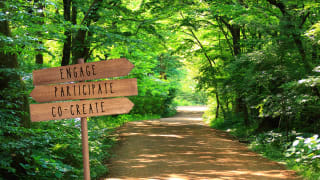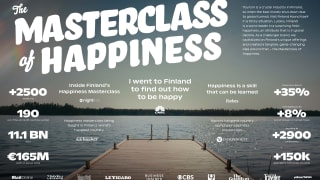Defining place branding
Place branding is a challenging field in and of itself – and that’s before you consider the discrepancies in the way that people use terminology.
It’s something that we’ve talked about a lot within the City Nation Place team, and so we wanted to share our definitions of key phrases to propose a standardisation for the community.
What is a place brand?
To put it briefly, your place brand is your reputation.
Let’s unpack that a bit, shall we?
Your place brand is the summation of your actions (past and present), your assets, your people, and your values. It’s the intersection of the different perceptions of your place that is held by everyone who interacts with you – whether they’re a resident, a visitor, or someone reading about the latest news coverage.
It exists independently from you, from your organisation, or from your work. Your place brand exists, whether you do anything about it or not.
What is place branding?
Place branding is the strategic process of building the reputation that you feel your place deserves.
It is the work that is undertaken at a district, city, regional, or national level to identify a consistent narrative that unites stakeholders and speaks to the authentic truth of your place. It’s reputation management, pure and simple.
However, place branding is distinct from traditional ‘branding.’ In part, this is due to the length of time that most places have existed: Coca Cola was founded in 1892. London, by comparison, was founded in around AD50 – not even counting the pre-historic remains that have been discovered from long before Romans began construction of ‘Londinium.’ Changing perceptions of something that has existed for millennia takes a longer-term perspective, simply because many of those perceptions are so entrenched in our cultural psyches.
The other core difference is that places are living. Your residents create and re-create your place every day and are active participants in shaping your place brand, whether they know it or not. To paraphrase, London & Partners’ CEO, Laura Citron, London has nine million Chief Marketing Officers. Coca Cola only has the one.
The place branding toolkit
What tools are at your disposal to manage your place brand then?
First up is your place brand identity. This is how you communicate your place brand promise: your unifying narrative, your visual identity, your brand guidelines.
Second is your place marketing. This includes your website[s], and the initiatives and campaigns that you use to attract talent, visitors, or investment, or to build awareness of your place. They are distinct communication bursts that draw on your overarching place brand, but are distinct and have specific objectives they’re working towards.
Finally, there is placemaking, which is the investment you make into the physical attractiveness of your place. This could be re-thinking your wayfinding, developing a programme of cultural activities, or redesigning a street to create spaces for residents to connect with one another. As a note, this is sometimes called placeshaping, and the two terms are often used fairly interchangeably.
Of course, this isn’t the be all and end all the tools at your disposal, but they are the most commonly used and referenced.
Place branding vs destination branding vs investment branding
Place branding extends to cover the breadth and depth of your place, whereas a destination or investment brand strategy speaks to a distinct audience. For example, a destination brand typically offers a lifestyle proposition, built around cultural and physical assets and / or community values. However, if it hasn’t been adopted by the teams responsible for investment promotion or talent attraction, it’s not servicing the full spectrum of your place and therefore isn’t what we would consider a ‘place brand.’
This isn’t a criticism. We’re not academics, and we’re not purists about place branding. At the end of the day, you sometimes have to work within the confines of your government, your funding structures, and the hundreds of other constraints you face every day. In many places, the structural, funding, or political challenges can impede collaboration and the longer-term commitment that a place branding strategy requires.
Instead, budgets are usually tied up in driving tourism or trade or even civic pride. Beginning your destination or investment brand where there is interest and support is no better or worse than launching a holistic place branding strategy. The key is that you’re able to create impact for your place – and then slowly growing your work from there once you have evidence to demonstrate this impact to your budget holders.
Cleveland is a great example of a destination brand that is growing into a place brand strategy. Launched in 2014, Destination Cleveland’s initial remit was to change perceptions amongst three target audiences: meeting planners and attendees; leisure travellers; and residents. However, within that focus, the team had huge success. For example, only 54% of residents would recommend Cleveland as a place to visit in 2015, but by 2021 that number had rocketed to 81%. Off the back of these successes, the team has expanded their approach considerably, and they are now working to create a Resident Ambassador programme to support the city’s talent attraction, and they are key partners of the Cleveland Talent Alliance.
In short?
Start wherever you need to in order to make the changes you want to see in your place.
What next?
While place brands are as old as our places, the field of place branding – the strategic management of your place brand – is relatively new. We’re all learning and growing, and even in the last ten years of City Nation Place, we’ve seen so much development in what place brands aspire to and the real-world impact they can create.
Whether you’re getting started or you’re looking to improve your approach in a specific area, here are some resources you should find helpful:
The impact of nation and place brands on the local and global economy
Bloom Consulting - in partnership with City Nation Place - have successfully demonstrated the correlation between perception and economic performance. Discover the definitive answer to the economic impact a positive perception has on your place.
Structure and governance for successful place branding and marketing
This report provides a summary of a survey of just under 40 organisations around the world and seven in-depth interviews to provide a better understanding of the pros and cons of different approaches. Download the report to learn what’s working, where the challenges are, and how places are adapting their structures and funding to better support their evolving objectives.
The Citizen Engagement Toolkit
This toolkit curates best practice in citizen engagement from around the world, giving you a taste of the different approaches taken by individual cities, regions, or nations. Along with how-to advice, this free toolkit provides you with a range of tools and resources used by each place to allow you to dig in and discover the engine whirring at the heart of each strategy.
The private sector perspective on place branding and marketing
This report looks at how places can engage the private sector in their strategic approaches to building and managing a strong and positive place brand. Discover how to gain a better understanding of the attitudes of private sector business leaders and start-up entrepreneurs to the importance of place reputation.
Solving the measurement challenge
Discover how place brand and marketing teams around the world are investing in data and research to measure the impact of their work and advocate for their role. Along with topline findings from our quantitative survey of place leaders, the report contains summaries of interviews with place leaders from around the world.









